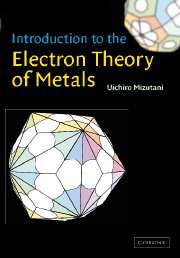Book contents
- Frontmatter
- Contents
- Preface
- 1 Introduction
- 2 Bonding styles and the free-electron model
- 3 Electrons in a metal at finite temperatures
- 4 Periodic lattice, and lattice vibrations in crystals
- 5 Conduction electrons in a periodic potential
- 6 Electronic structure of representative elements
- 7 Experimental techniques and principles of electronic structure-related phenomena
- 8 Electronic structure calculations
- 9 Electronic structure of alloys
- 10 Electron transport properties in periodic systems (I)
- 11 Electron transport properties in periodic systems (II)
- 12 Superconductivity
- 13 Magnetism, electronic structure and electron transport properties in magnetic metals
- 14 Electronic structure of strongly correlated electron systems
- 15 Electronic structure and electron transport properties of liquid metals, amorphous metals and quasicrystals
- Appendix 1 Values of selected physical constants
- Principal symbols (by chapter)
- Hints and answers
- References
- Materials index
- Subject index
3 - Electrons in a metal at finite temperatures
Published online by Cambridge University Press: 20 November 2009
- Frontmatter
- Contents
- Preface
- 1 Introduction
- 2 Bonding styles and the free-electron model
- 3 Electrons in a metal at finite temperatures
- 4 Periodic lattice, and lattice vibrations in crystals
- 5 Conduction electrons in a periodic potential
- 6 Electronic structure of representative elements
- 7 Experimental techniques and principles of electronic structure-related phenomena
- 8 Electronic structure calculations
- 9 Electronic structure of alloys
- 10 Electron transport properties in periodic systems (I)
- 11 Electron transport properties in periodic systems (II)
- 12 Superconductivity
- 13 Magnetism, electronic structure and electron transport properties in magnetic metals
- 14 Electronic structure of strongly correlated electron systems
- 15 Electronic structure and electron transport properties of liquid metals, amorphous metals and quasicrystals
- Appendix 1 Values of selected physical constants
- Principal symbols (by chapter)
- Hints and answers
- References
- Materials index
- Subject index
Summary
Prologue
In Chapter 2, we constructed the Fermi sphere of free-electrons with the radius kF in reciprocal space. It represents the distribution of the quantized electronic states at absolute zero, in which the states in k≤kF are all occupied but those in k>kF are vacant. At finite temperatures, thermal energy would excite some electrons in the range k≤kF into the range k>kF. The redistribution of electrons will occur so as not to violate the Pauli exclusion principle. As noted in Section 2.7, the Fermi energy in typical metals is of the order of several eV and is equivalent to ∼ 10000K on the temperature scale. Hence, only electrons near the Fermi surface can be excited at temperatures below ∼ 1000K. The aim of the present chapter is to formulate first the Fermi–Dirac distribution function, which determines the distribution of electronic states or the Fermi surface at finite temperatures, and then to deduce the temperature dependence of various physical properties due to conduction electrons by calculating relevant quantities involving the Fermi–Dirac distribution function.
Fermi–Dirac distribution function (I)
We know that the velocity of dilute gas molecules obeys the Maxwell–Boltzmann distribution law. Unfortunately, however, classical statistics cannot be applied to the conduction electron system in metals because of an extremely high electron density of the order of 1028–1029/m3. As emphasized in the preceding chapter, an electron carries a spin of ½ and particles with a half-integer spin should obey the Pauli exclusion principle. In addition, they are indistinguishable from each other. Our first objective in this section is to deduce the statistical distribution function under these two conditions imposed by quantum mechanics.
- Type
- Chapter
- Information
- Introduction to the Electron Theory of Metals , pp. 29 - 53Publisher: Cambridge University PressPrint publication year: 2001

